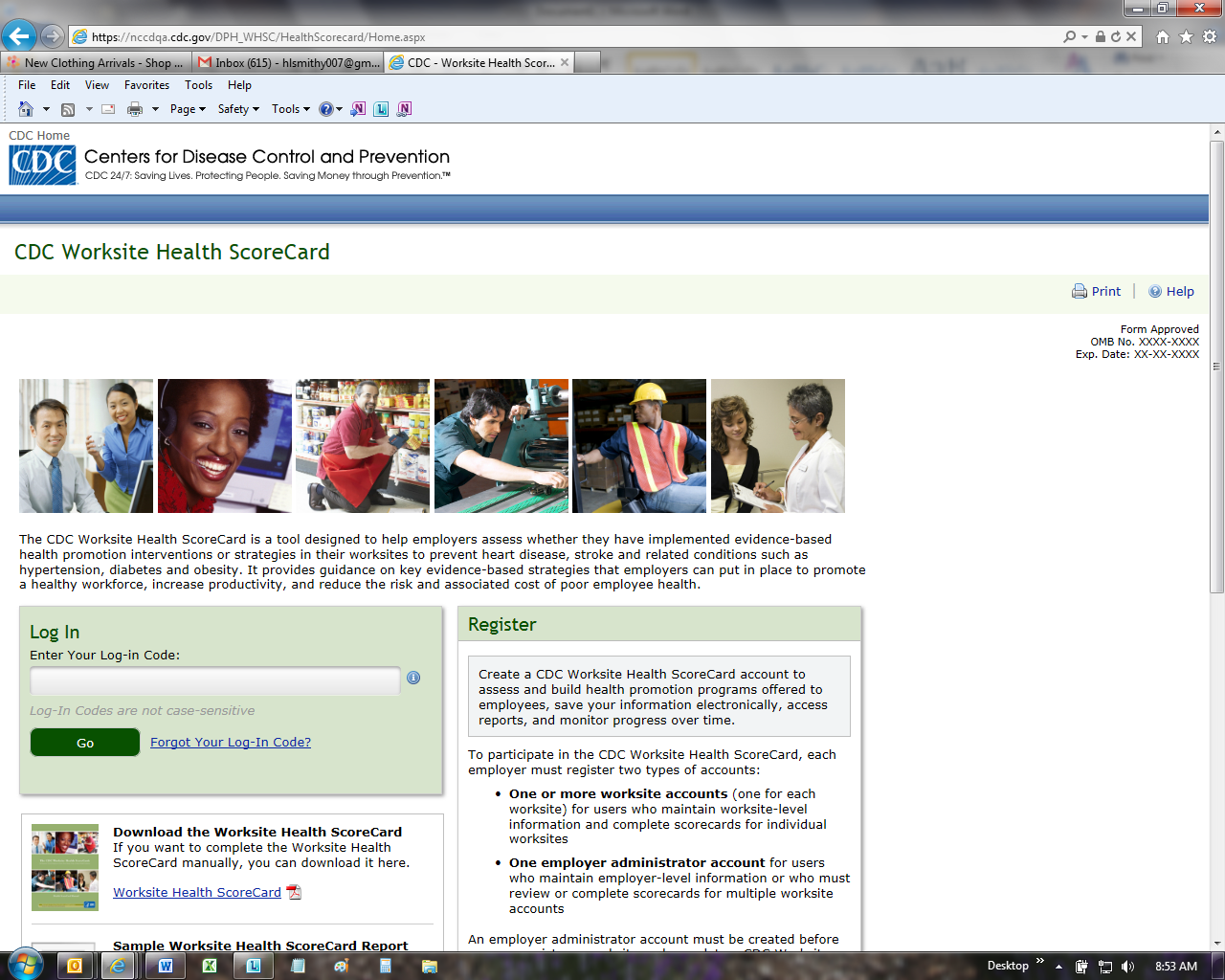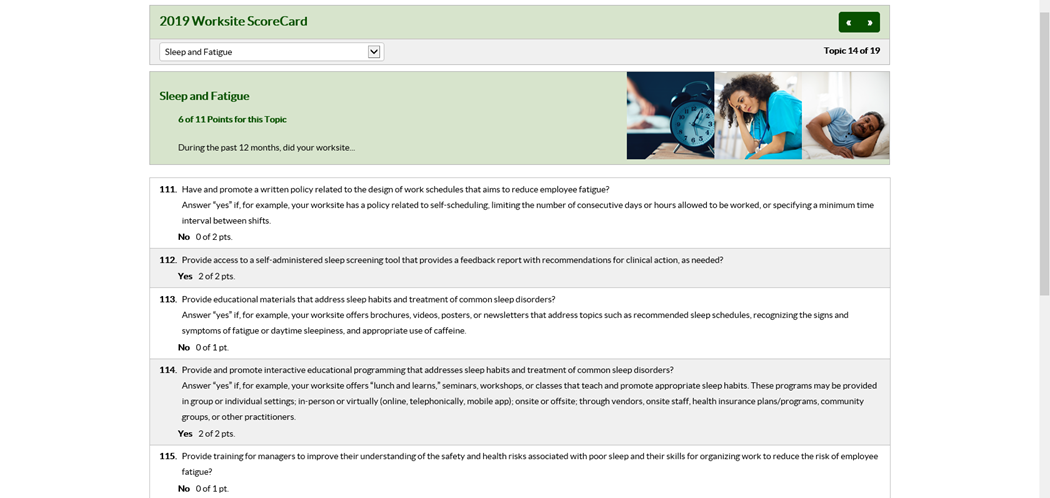Form 0920-1014 CDC Worksite Health Scorecard
CDC Worksite Health Scorecard
Attachment_C-2_CDC Worksite Health ScoreCard_12-15-21_final
CDC Worksite Health Scorecard
OMB: 0920-1014
Form Approved
OMB No. 0920-1014
Exp. Date: XX/XX/XXXX
CDC Worksite Health Scorecard
Public reporting of this collection of information is estimated to average 75 minutes per response, including the time for reviewing instructions, searching existing data sources, gathering and maintaining the data needed, and completing and reviewing the collection of information. An agency may not conduct or sponsor, and a person is not required to respond to a collection of information unless it displays a currently valid OMB control number. Send comments regarding this burden estimate or any other aspect of this collection of information, including suggestions for reducing this burden to CDC/ATSDR Reports Clearance Officer, 1600 Clifton Road NE, MS D-74, Atlanta, Georgia 30333; ATTN: PRA (0920-1014).
Respondents/Sources |
Method |
Content |
Timing |
Respondents |
Time per Respondent |
Employers (e.g., wellness/ human resources Representative) |
Online |
|
Participants may begin the survey immediately after they agree to participate, establish an account, and receive a login code via email. |
800 |
1.25 hrs |
The CDC Worksite Health ScoreCard is a tool designed to help employers assess whether they have implemented evidence-based health promotion interventions or strategies in their worksites to prevent heart disease, stroke, and related conditions such as hypertension, diabetes, and obesity.
Although chronic diseases are among the most common and costly of all health problems, adopting healthy lifestyles can help prevent them. A wellness program aimed at keeping employees healthy is a key long-term human asset management strategy. To curb rising health care costs, many employers are turning to workplace health programs to make changes in the worksite environment, help employees adopt healthier lifestyles and, in the process, lower their risk of developing costly chronic diseases. The approach that has proven most effective is to implement an evidence-based comprehensive health promotion program that includes individual risk reduction programs, coupled with environmental supports for healthy behaviors and is coordinated and integrated with other wellness activities. To better understand these employer-based workplace health programs, the U.S. Centers for Disease Control and Prevention (CDC) is conducting this organizational survey of employer workplace health programs, policies, and practices.
The assessment contains 154 questions that assess how evidence-based health promotion strategies are implemented at a worksite. These strategies include health promoting counseling services, environmental supports, policies, health plan benefits, and other worksite programs shown to be effective in preventing heart disease, stroke, and related health conditions. Employers can use this tool to assess how a comprehensive health promotion and disease prevention program is offered to their employees, to help identify program gaps, and to prioritize across the following health topics:
Organizational Supports (25 questions)
Tobacco Use (8 questions)
Nutrition (14 questions)
Physical Activity (10 questions)
Weight Management (4 questions)
Stress Management (7 questions)
Depression (7 questions)
High Blood Pressure (6 questions)
High Cholesterol (5 questions)
Prediabetes and Diabetes (6 questions)
Heart Attack and Stroke (12 questions)
Alcohol and Other Substance Use (6 questions)
Maternal Health Lactation Support (7 questions)
Sleep and Fatigue (8 questions)
Occupational Health and Safety (9 questions)
Vaccine-Preventable Diseases (6 questions)
Musculoskeletal Disorders (7 questions)
Cancer (7 questions)
In this survey, worksite is defined as a building, unique location, or business unit within an organization where work occurs. A worksite can include a campus of multiple buildings if all buildings are in close proximity (walking distance) and defined as part of the organization.
On average, it will take you 75 minutes to complete the survey. You may need to consult with another person to provide the most accurate and complete information on your workplace health programs, policies, and practices. Examples of people to consult with include human resource managers, health benefit managers, health education staff, occupational nurses, medical directors, wellness directors, or others responsible for worksite health promotion in an organization.
Completing the survey is voluntary. No names will ever be reported.
If you have any questions, you can contact Jason Lang at the Centers for Disease Control and Prevention. His phone number is 770-488-5597and his email is jlang@cdc.gov.
Instructions
Answer “yes” or “no” for each question on the tool.
All questions should be answered consistently with your worksite practices and programs that are current or that have been in place within the last 12 months.
There are 19 sections to the tool; you may complete each section in separate sittings and in any order. Individual scores can be tallied for each section and combined for an overall score once all sections are completed. The entire survey will take approximately 75 minutes to complete.
We recommend that you form a small team, representing different organizational units to complete this survey together. A team-based approach will allow for more accurate responses, increase ownership and involvement amongst the team, and decrease effort for any single team member. Since a strong knowledge of your organization and its health promotion program(s) is recommended to accurately complete the tool, strive to pick team members who occupy the following positions:
o Members of a worksite health promotion committee
o Human resource managers
o Health benefits managers
o Health education staff
o Occupational nurses
o Medical directors
o Wellness directors
o Health promotion coordinators
o Building facilities managers
Scan each section before attempting to respond. Answers to most questions are readily available following a review of organizational health policies (e.g., a policy handbook), benefit plan designs, interviews with key stakeholders, and direct observation. In some cases, answers may not be immediately obvious to the person assigned to complete the section. If you do not know the answer to the question, leave the box empty, and then engage others at the worksite to help you answer it.
Some questions ask you to describe your health insurance plan. If your organization offers more than one health insurance option, refer to the health insurance plan with the highest enrollment.
Throughout the survey, questions refer to “health promotion” at your worksite. This is also known as “worksite wellness” or “wellness programs”.


Module 1: Worksite Demographics (8 questions)


Module 2: Organizational Support (Q#1-Q#25)




Module 3: Tobacco Use (Q#26-Q#33)


Module 4: High Blood Pressure (Q#34-Q#39)


Module 5: High Cholesterol (Q#40-Q#44)

Module 6: Physical Activity (Q#45-Q#54)


Module 7: Weight Management (Q#55-Q#58)

Module 8: Nutrition (Q#59-Q#72)



Module 9: Heart Attack and Stroke (Q#73-Q#84)


Module 10: Prediabetes and Diabetes (Q#85-Q#90)


Module 11: Depression (Q#91-Q#97)


Module 12: Stress Management (Q#98-Q#104)


Module 13: Alcohol and Other Substance Use (Q#105-Q#110)


Module 14: Sleep and Fatigue (Q#111-Q#118)


Module 15: Musculoskeletal Disorders (Q#119-Q#125)


Module 16: Occupational Health and Safety (Q#126-Q#134)


Module 17: Vaccine Preventable Diseases (Q#135-Q#140)


Module 18: Maternal Health and Lactation Support (Q#141-Q#147)


Module 19: Cancer (Q#148-Q#154)


| File Type | application/vnd.openxmlformats-officedocument.wordprocessingml.document |
| Author | Lang, Jason (CDC/ONDIEH/NCCDPHP) |
| File Modified | 0000-00-00 |
| File Created | 2022-02-08 |
© 2025 OMB.report | Privacy Policy